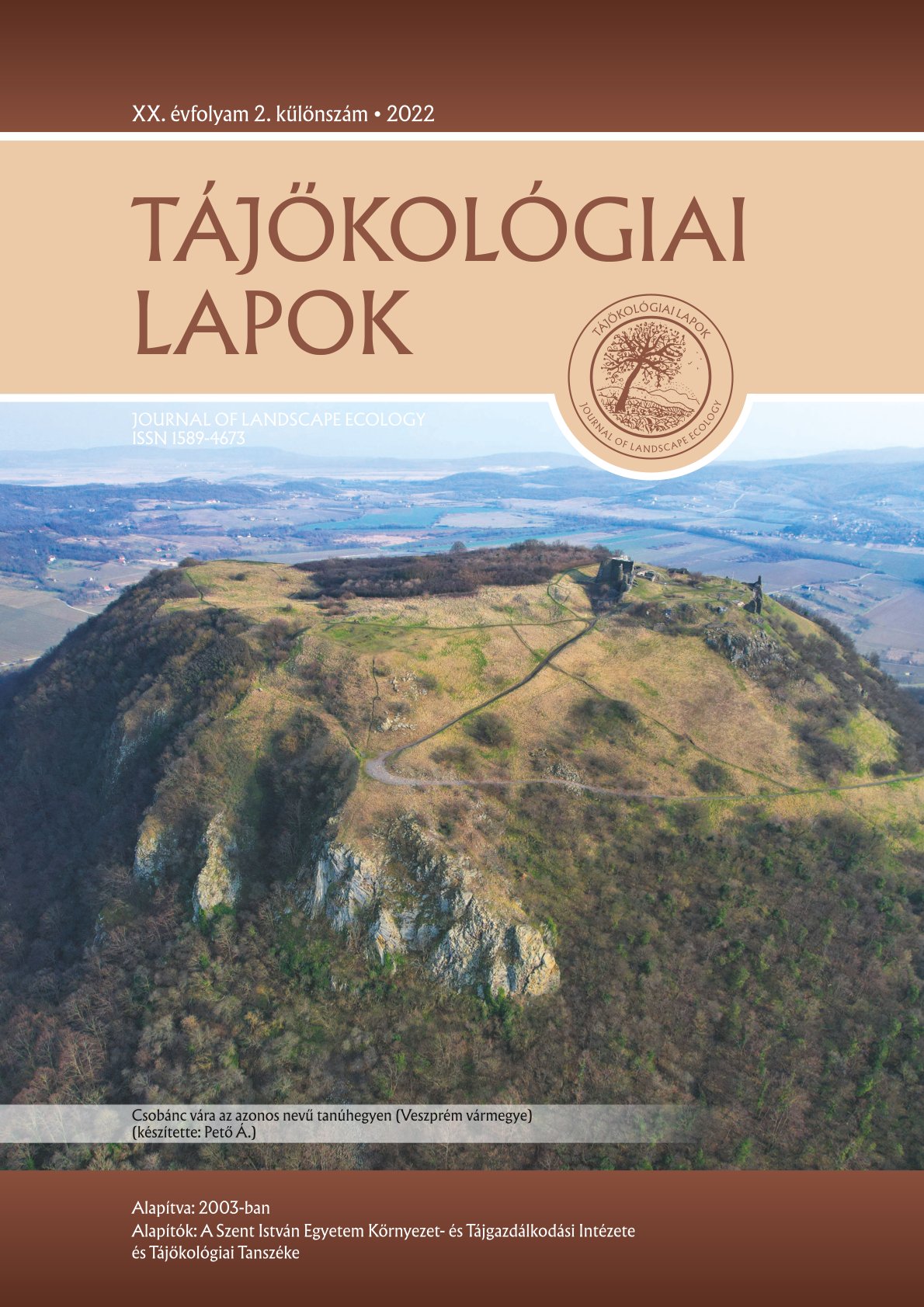Testing the effects of pesticides with enchytraeus albidus avoidance test
DOI:
https://doi.org/10.56617/tl.3978Keywords:
Quadris, Flumite 200, Enchytraeus albidus, avoidance test, field density dataAbstract
Chemical plant protection is a dominant practice in agriculture. Therefore, investigating the side effects of pesticides on non-target species is a critical task for ecotoxicologists. Accordingly, the effects of a fungicide Quadris (a.i. azoxystrobin), and an acaricide Flumite 200 (a.i. flufenzin), were investigated separately and as a mixture. Both pesticides are often used in domestic viticulture contemporary. Environmental samplings were carried out before and after the pesticide application and based on OECD standards avoidance tests were implemented on enchytraeid species Enchytraeus albidus. At some concentrations, test animals showed avoidance. However, these concentrations were several orders higher than the recommended application concentrations. Based on these observations, we believe that enchytraeids can sense and avoid the applied pesticides. Therefore, tested pesticides do not have a significant environmental toxicity risk to enchytraeid worms when used according to recommendations.
References
Ábrahám R., Érsek T., Kuroli G., Németh L., Reisinger P. 2011: Precíziós növényvédelem. https://dtk.tankonyvtar.hu/bitstream/handle/123456789/8619/0010_1A_Book_08_Novenyvedelem.pdf?sequence=2&isAllowed=y
Amorim, M.J.B., Novais, S., Römbke, J., Soares, A.M.V.M. 2008: Enchytraeus albidus (Enchytraeidae): A test organism in a standardised avoidance test? Effects of different chemical substances. Environment International 34(3): 363–371. DOI: https://doi.org/10.1016/j.envint.2007.08.010
Amorim, M.J.B., Scott-Fordsmand, J.J. 2012: Toxicity of copper nanoparticles and CuCl2 salt to Enchytraeus albidus worms: Survival, reproduction and avoidance responses. Environmental Pol-lution 164: 164–168. DOI: https://doi.org/10.1016/j.envpol.2012.01.015
Bardgett, R. 2005: The biology of soil: A community and ecosystem approach. Oxford University Press, Oxford.
Barna Sz. 2008: Növényekre adaptálható gyors bioteszt kidolgozása talajok nehézfém-tartalmának jellemzésére. Doktori értekezés. Szent István Egyetem, Környezettudományi Doktori Iskola, Gödöllő.
Bartlett, D.W., Clough, J.M., Godwin, J.R., Hall, A.A., Hamer, M., Parr-Dobrzanski, B. 2002: The stro-bilurin fungicides. In: Pest Management Science 58(7): 649–662. DOI: https://doi.org/10.1002/ps.520
Brussaard, L., de Ruiter, P.C., Brown, G.G. 2007: Soil biodiversity for agricultural sustainability. Ag-riculture, Ecosystems and Environment 121(3): 233–244. DOI: https://doi.org/10.1016/j.agee.2006.12.013
Coleman, D.C. 2008: From peds to paradoxes: Linkages between soil biota and their influences on ecological processes. Soil Biology and Biochemistry 40(2): 271–289. DOI: https://doi.org/10.1016/j.soilbio.2007.08.005
Coleman, D.C., Crossely, D.A., Hendrix, P.F. 2004: Fundamentals of Soil Ecology. Academic Press. DOI: https://doi.org/10.1016/C2015-0-04083-7
Csorba P., Ádám Sz., Bartos-Elekes Zs., Bata T., Bede-Fazekas Á., Czúcz B., Csima P., Csüllög G., Fo-dor N., Frisnyák S. et al. 2018: Tájak. In: Kocsis K. (főszerk.): Magyarország nemzeti atlasza 2. kö-tet. Természeti környezet. MTA CSFK Földrajztudományi Intézet, Budapest, pp. 112–129. https://www.nemzetiatlasz.hu/MNA/MNA_2_10.pdf
Dai, W., Slotsbo, S., Holmstrup, M. 2021: Thermal optimum for mass production of the live feed or-ganism Enchytraeus albidus. Journal of Thermal Biology 97: 102865. DOI: https://doi.org/10.1016/j.jtherbio.2021.102865
Didden, W. 1991: Population ecology and functioning of Enchytraeidae in some arable farming systems. Doktori értekezés. Wageningen University and Research ProQuest Dissertations Publishing.
Didden, W.A.M., Römbke, J. 2001: Enchytraeids as organisms for chemical stress in terrestrial ecosystems. Ecotoxicology and Environmental Safety 50(1): 25–43. DOI: https://doi.org/10.1006/eesa.2001.2075
Dózsa-Farkas K. 2002: Mit érdemes tudni a televényférgekről (Enchytraeidae, Annelida)? Állattani közlemények 87: 149–164.
Havasi, M., Kheradmand, K., Mosallanejad, H., Fathipour, Y. 2019: Sublethal effects of diflovidazin on demographic parameters of the predatory mite, Neoseiulus californicus (Acari: Phytoseiidae). International Journal of Acarology 45(4): 238–244. DOI: https://doi.org/10.1080/01647954.2019.1607550
Killham, K. 1994: Soil ecology. Cambridge University Press, Cambridge.
Kodandaram, M.H., Kumar, Y.B., Rai, A.B., Singh, B. 2016: An overview of insecticides and acari-cides with new chemistries for the management of sucking pests in vegetable crops. Vegetable Science 43(1): 1–12.
Newman, M.C. 2014: Fundamentals of ecotoxicology. Taylor & Francis, London.
O'Connor, F.B. 1962: The extraction of Enchytraeidae from soil. In: Murphy, P.W. (ed.) Progress in soil zoology, Butterworths, London, pp 398.
OECD 2009: OECD Guidlines fot Testing Themicals, No. 232 Collembolan reproduction test in soil.
OECD 2016: OECD Guideline for the Testing of Chemicals, No. 220 Enchytraeid reproduction test.
Pelosi, C., Römbke, J. 2016: Are Enchytraeidae (Oligochaeta, Annelida) good indicators of agricultural management practices? Soil Biology and Biochemistry 100: 255–263. DOI: https://doi.org/10.1016/j.soilbio.2016.06.030
R Developement Core Team 2019: R: a language and environment for statistical computing, https://www.r-project.org.
Somogyi Z., Bakonyi G., Kiss I. 2005: Ökotoxikológiai vizsgálatok televényférgekkel (Annelida: Enchitraeidae). Agrokémia és Talajtan 54(3–4): 535–545. DOI: https://doi.org/10.1556/agrokem.54.2005.3-4.21
Vavoulidou, E., Coors, A., Dózsa-Farkas, K., Römbke, J. 2009: Influence of farming practice, crop type and soil properties on the abundance of Enchytraeidae (Oligochaeta) in Greek agricultural soils. Soil Organisms 81(2): 197–212.
Wang, Y., Wu, S., Chen, L., Wu, C., Yu, R., Wang, Q., Zhao, X. 2012: Toxicity assessment of 45 pesticides to the epigeic earthworm Eisenia fetida. Chemosphere 88(4): 484–491. https://doi.org/10.1016/j.chemosphere.2012.02.086
Downloads
Published
Issue
Section
License
Copyright (c) 2022 Révész Anna, Szabó Borbála, Boros Gergely

This work is licensed under a Creative Commons Attribution-NonCommercial-NoDerivatives 4.0 International License.
A folyóirat Open Access (Gold). Cikkeire a Creative Commons 4.0 standard licenc alábbi típusa vonatkozik: CC-BY-NC-ND-4.0. Ennek értelmében a mű szabadon másolható, terjeszthető, bemutatható és előadható, azonban nem használható fel kereskedelmi célokra (NC), továbbá nem módosítható és nem készíthető belőle átdolgozás, származékos mű (ND). A licenc alapján a szerző vagy a jogosult által meghatározott módon fel kell tüntetni a szerző nevét és a szerzői mű címét (BY).












